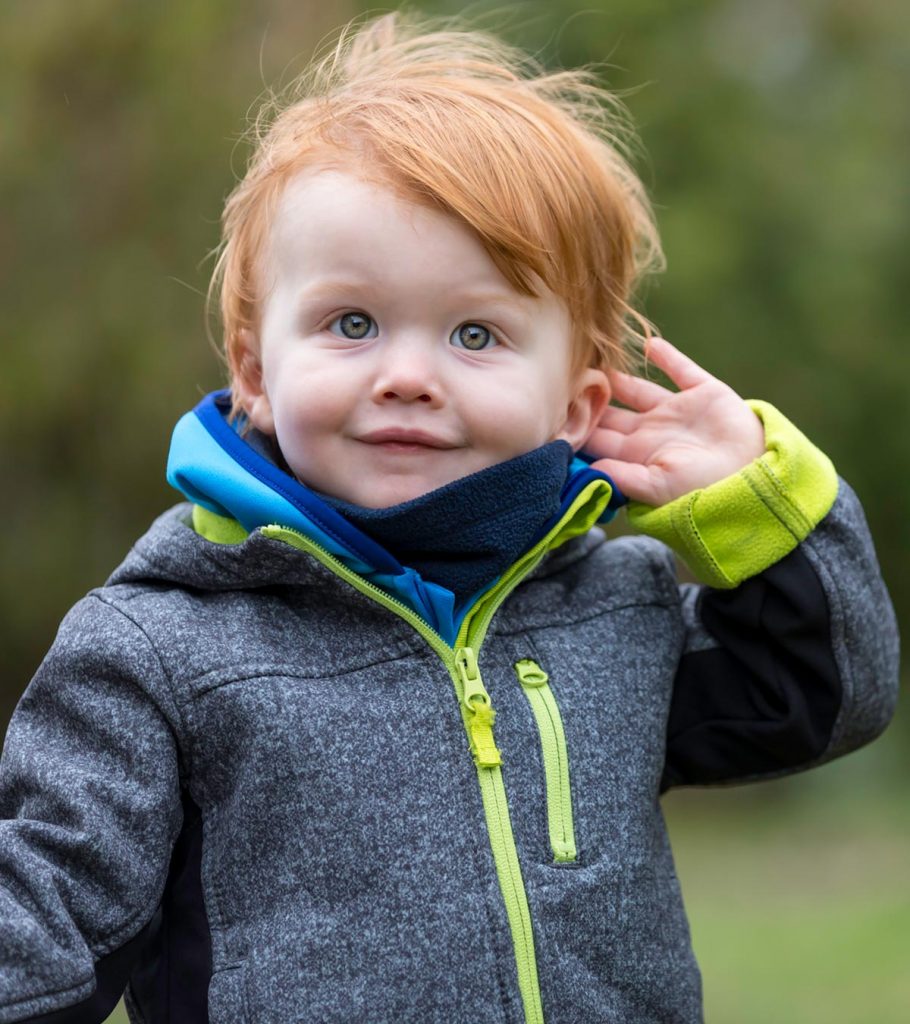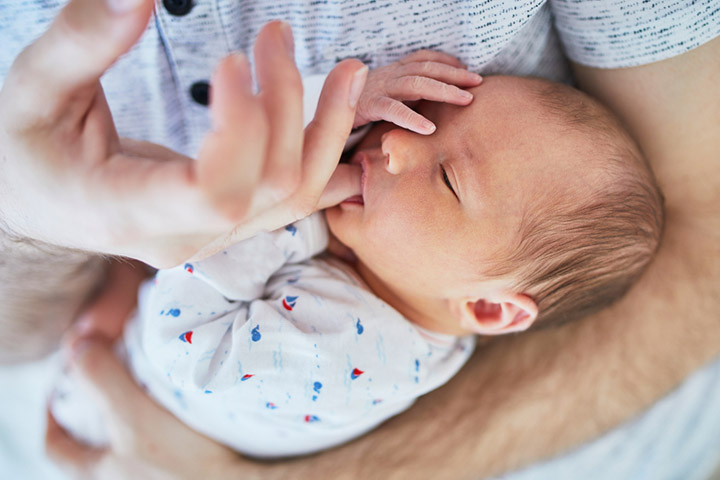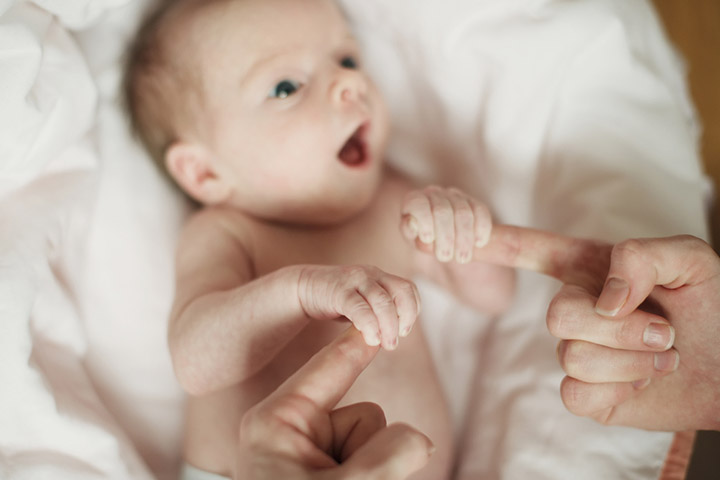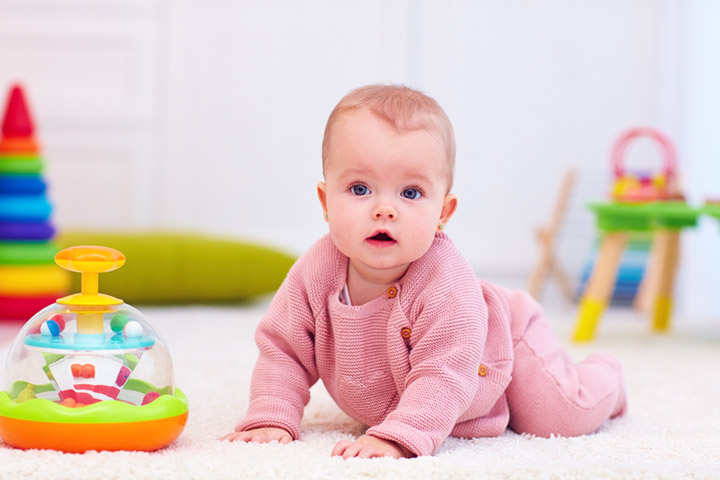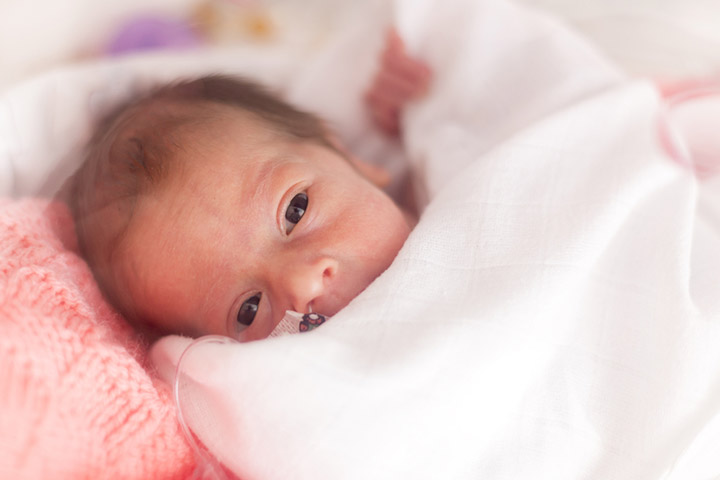A reflex is an involuntary or automatic action to a response. Primitive reflexes in babies originate from the central nervous system and indicate a healthy baby. Conversely, the absence of these fundamental reflexes may imply neurological conditions and hence is a cause for concern.
There are various types of primitive reflexes. Read on to know more about them and reflex integration. We have also mentioned the conditions that may cause an absence of primitive reflexes and the reasons for their reappearance during toddlerhood.
Which Reflexes Are Present In A Newborn?
The following reflexes are present in newborn babies (1).
1. Rooting reflex
If the corner of the mouth is stroked or touched, the baby turns their head and opens their mouth to root or search for the source of the touch. This instinctive response is called the rooting reflex since the baby tries to root in the direction of touch. Rooting reflex helps babies reach the breast or bottle nipple for feeding. Rooting reflex lasts up to four months of age in healthy babies (2).
Oral primitive reflexes, such as rooting reflex, are required for feeding. Lactation specialists and nurses in newborn care may look for these rudimentary reflexes to assess the baby’s health.
2. Sucking reflex
The sucking reflex occurs when the baby’s lips or mouth are touched and the baby begins sucking. It helps the baby start feeding when the breast or bottle nipple touches their mouth (3).
This innate reflex begins around 32 weeks of pregnancy and fully develops by 36 weeks. Premature babies usually have undeveloped, immature, or weak suck reflexes, making it difficult for them to feed without assistance. However, preemies may have the hand-to-mouth reflex or Babkin reflex that is rotation and flexion of the head, usually with opening of the mouth in response to pressure applied on the palms (4). This elemental reflex may lead to hand or finger-sucking in preemies.
3. Moro reflex
Moro reflex is also known as startle reflex since this occurs when an infant is startled by movement or any sound. In response to sudden movement or sound, the baby throws their head and extends arms and legs, cries, and then pulls back the limbs to their original position.
Babies may also display Moro reflex in response to their own cry. The reflex may last up to two months of age. It is due to this reflexive movement that you may have to be extra careful while holding a newborn since they may throw their limbs due to the Moro reflex making you lose grip.
4. Tonic neck reflex
Tonic neck reflex occurs when a baby’s head turns to one side. The arm on the side to which the head turns stretches out while the opposite arm bends at the elbow. It resembles a stance used in the sport of fencing, and it is also called the fencing reflex or fencer position. The reflex may last up to six months of age.
5. Grasp reflex
Babies close their hand and grasp the finger or the object that stroked their palm. This is called grasp reflex, and it may last up to six months of age.
You may also notice a natural grasp reflex on the toes of a newborn. If you touch their sole, they flex the toe to grasp. Plantar grasp reflex (on toes) may last longer than palmar grasp reflex (on hands). You may notice plantar grasp reflex up to nine to 12 months of age.
6. Stepping reflex
Stepping reflex occurs when a baby’s foot touches a solid surface when they are held in an upright position. They begin to take steps due to this congenital reflex. This is also called the walking or dancing reflex, and it may last for two months after birth.
7. Galant reflex
Infants twitch their hips towards the side of touch in a dancing movement if the side of their spine is stoked or touched while they lie on their stomachs. This is also known as truncal incurvation reflex and is usually examined at birth to exclude brain damage. Galant reflex is an inherent reflex and can be seen from birth to four or six months of age.
8. Tonic labyrinthine reflex (TLR)
Tonic labyrinthine reflex is seen in newborn babies. They tilt their head backward when lying on their back or when lifted on their back, causing the baby’s back to arch and stiffen. This reflex may also cause infants to point their toes, bend their arms, and curl their fingers. TLR usually disappears within the first six months of life.
9. Asymmetrical tonic neck reflex (ATNR)
Asymmetrical tonic neck reflex (ATNR) is also called fencing reflex due to the baby’s fencer position. When you turn the baby’s face to one side, the arms and legs on that side extend, while the limbs on the other side flex. Turn the baby’s head to the opposite side and the limbs’ extension and flexion change accordingly. This reflex usually disappears after six months of age.
What Is Reflex Integration?
The modification of primitive reflexes into motor activities by the higher brain centers is known as reflex integration (5). The nervous system gradually inhibits these reflexes within four to six months of age. It means infantile primitive reflexes are replaced by voluntary motor activities by the mature brain.
Infants with normal brain development will have reflex integration on time. Some neurological conditions may cause delay or failure in reflex integration. Some may have reappearing reflexes if higher brain centers are damaged. It is for these reasons that primitive reflexes are normal in babies up to a certain age and may indicate neurological problems when reflexes persist or reappear.
What Happens When Primitive Reflexes Are Retained?
The existence of primitive reflexes beyond their expected duration of presence may indicate neurological developmental issues. It usually indicates the higher brain centers’ failure to inhibit the reflexes through reflex integration (6).
Retained primitive reflexes may affect the psychomotor development of a baby, which means that it may affect the child’s social and behavioral skills. Infants with retained reflexes may require reflex integration therapies to enhance their brain development. Seek medical care if you notice any retained primitive reflexes in your baby beyond the milestone. In most cases, a pediatrician can detect the retention of primitive reflexes during routine checkups.
Why Are Primitive Reflexes Absent In Some Infants?
Abnormal reflexes and lack of infantile primitive reflexes indicate that the brain is immature. Pediatricians may look for primitive reflexes during the newborn’s neurological examination to assess the baby’s neurological maturity. The abnormal or lack of reflexes in newborns can be due to central nervous system (CNS) pathologies. These may include (7):
- Basal gangliaiXA group of structures found deep inside the brain responsible for motor learning and behavior pathologies
- Brainstem dysfunctioniXA condition in which the bottom part of the brain connecting the spinal cord is not able to function properly
- Cerebral palsyiX A muscle disorder causing difficulty in movement due to brain damage before birth
- Delay in motor development
- Mental delays
Premature babies and low birth weight infants may have weak Moro reflex due to low muscle tone and resistance to movements. The absence of this basic is often considered an indication of neuropathologies.
Note: The persistence of reflexes beyond six months or absence of primitive reflexes in early infancy may predict cerebral palsy. The existence of five or more abnormal reflexes is related to mental delays and cerebral palsy.
What Happens When Primitive Reflexes Reappear?
Primitive reflexes or frontal release signs may indicate pathologies of the frontal lobe of the brain. There could be a reappearance of single or multiple primitive reflexes depending on the neurological damage.
The type of reappearing reflex could indicate the type of neurological problem or the parts of the brain affected (8). The reappearance of primitive reflexes could occur in toddlerhood, childhood, or during adulthood.
- The reappearance of multiple primitive reflexes is seen in frontal lobe pathologies such as multiple sclerosisiXAn autoimmune disease that affects the central nervous system and damages the fatty tissues around the nerve fibers, Alzheimer’s diseaseiXA neurological disorder leading to a loss of memory due to damage to the brain cells, and schizophreniaiXA mental illness that affects people’s ability to think, feel, or behave, causing them to disconnect from reality.
- Grasp reflex and Babinski reflex are seen in people with dementia. Babinski reflex can be due to pyramidal tract lesion and upper neuron damage.
- Grasp reflex may reappear due to frontal lobe lesions, progressive supranuclear palsyiXA rare brain disorder causing difficulties in walking, balancing, and eye movements , Lewy body dementiaiXA common disorder affecting a person’s thinking process and characterized by changes in sleep, behavior, and movement, and corticobasal syndromeiXA slow-progressing condition that causes changes in movement or language due to brain or nerve cell damage .
- Palmomental reflexes (twitching of the chin when the palm is stroked) and glabellar reflex (blinking of eyes when the forehead is tapped) could be early signs of parkinsonismiXA group of neurological conditions causing a loss of nerve cells in the brain and characterized by slow movement and tremorsin adults.
- Sucking reflex and rooting reflex may reappear due to cerebral atrophy.iXA condition leading to a loss of brain cells or the connection between brain cells
- Snout reflex or pouting when the lips are touched may indicate frontal lobe lesion.
The reappearance of oral reflexes, such as sucking reflex and snout reflex, may result in malnutrition and aspiration pneumonia, depending on the age when the reflex reappeared. The reflexes may also interfere with normal eating and swallowing of the food.
Primitive reflexes in babies help an infant survive. These innate or inbuilt reflexes disappear as time passes and when the baby grows older. However, the retention or reappearance of these reflexes beyond infancy may indicate neurological issues. Therefore, consult your baby’s pediatrician as they may suggest some tests to diagnose the underlying cause. Do not forget to make regular pediatric visits to complete an assessment of your baby’s neurological functions. Keep in mind that the early diagnosis of this issue can help prevent severe brain damage.
Key Pointers
- A baby displays ten primitive reflexes, which indicate a healthy neurological condition, each lasting for a specific amount of time.
- After about six months, babies can calculate their movements and convert the primitive reflexes into voluntary reactions.
- Reflexes that last longer than usual or return may suggest a neurological problem. If your child’s symptoms of any reflexes persist, speak with their pediatrician.
Watch the video to learn how to assess newborn primitive reflexes like the Moro, Palmar, and Rooting reflexes.
